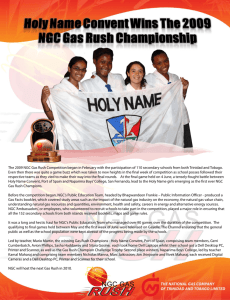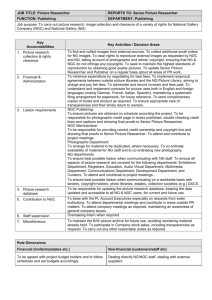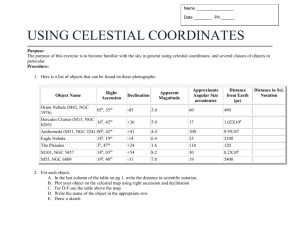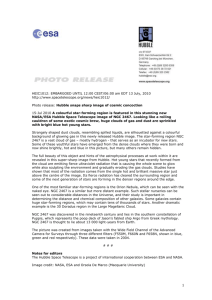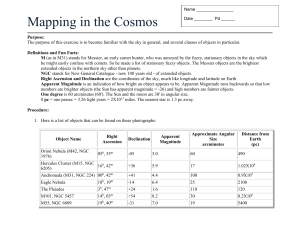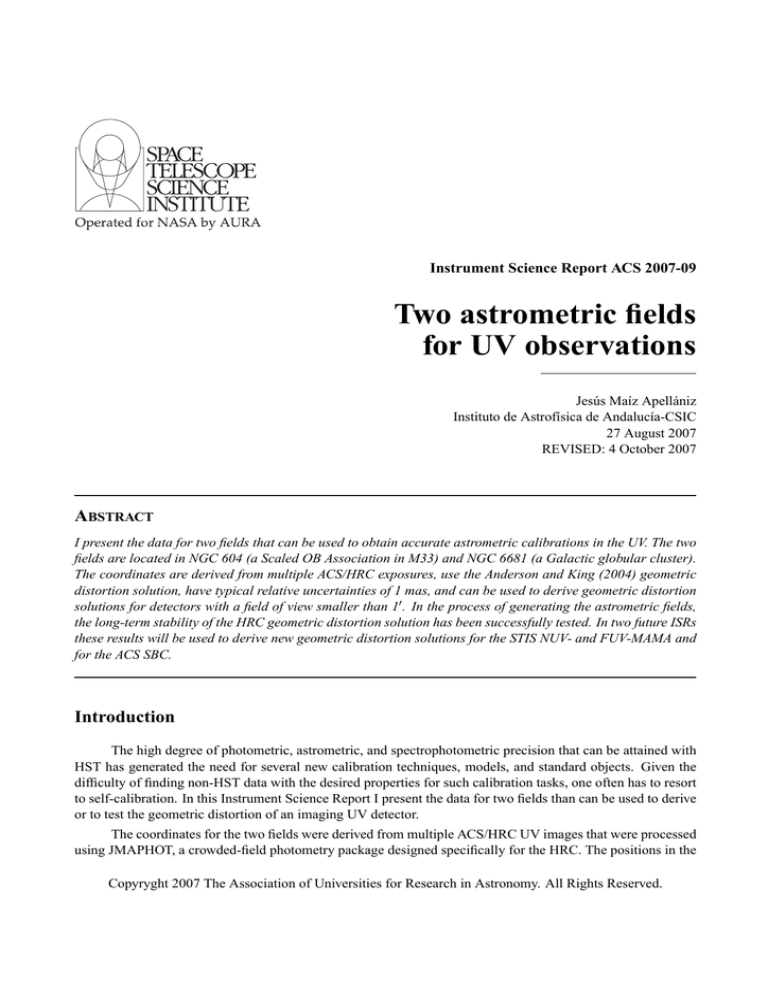
Instrument Science Report ACS 2007-09
Two astrometric fields
for UV observations
Jesús Maı́z Apellániz
Instituto de Astrofı́sica de Andalucı́a-CSIC
27 August 2007
REVISED: 4 October 2007
ABSTRACT
I present the data for two fields that can be used to obtain accurate astrometric calibrations in the UV. The two
fields are located in NGC 604 (a Scaled OB Association in M33) and NGC 6681 (a Galactic globular cluster).
The coordinates are derived from multiple ACS/HRC exposures, use the Anderson and King (2004) geometric
distortion solution, have typical relative uncertainties of 1 mas, and can be used to derive geometric distortion
solutions for detectors with a field of view smaller than 1′ . In the process of generating the astrometric fields,
the long-term stability of the HRC geometric distortion solution has been successfully tested. In two future ISRs
these results will be used to derive new geometric distortion solutions for the STIS NUV- and FUV-MAMA and
for the ACS SBC.
Introduction
The high degree of photometric, astrometric, and spectrophotometric precision that can be attained with
HST has generated the need for several new calibration techniques, models, and standard objects. Given the
difficulty of finding non-HST data with the desired properties for such calibration tasks, one often has to resort
to self-calibration. In this Instrument Science Report I present the data for two fields than can be used to derive
or to test the geometric distortion of an imaging UV detector.
The coordinates for the two fields were derived from multiple ACS/HRC UV images that were processed
using JMAPHOT, a crowded-field photometry package designed specifically for the HRC. The positions in the
Copyryght 2007 The Association of Universities for Research in Astronomy. All Rights Reserved.
Figure 1: F250W DRZ mosaic of the NGC 604 field. The stars in Table 3 are marked with blue circles. The
field is centered at 1h 34m 32.s 7088, 30◦ 47′ 5.′′ 501, has a size of 42.′′ 5 × 35.′′ 0, and the vertical direction is 49◦
East of North. The total exposure time is 2288 s.
detector were corrected using the Anderson and King (2004) geometric distortion solution for the HRC, which
was derived using multiple observations of the globular cluster 47 Tuc applying a self-calibration technique.
That solution is extremely accurate for an ideal case (positions measured in a dense field with a single orientation, a single epoch, and with certain filters), yielding uncertainties of ∼0.005 pixels (0.125 mas) for stars with
S/N = 1000, ∼0.02 pixels (0.5 mas) for stars with S/N = 100, and ∼0.1 pixels (2.5 mas) for stars with S/N =
30. The geometric distortion has two components: a polynomial fit common to all filters and a lookup table
which is filter dependent. Most of the distortion is contained in the polynomial fit, with the filter-dependent
tables introducing corrections of the order of only 0.05 pixels. Anderson and King (2004) did not provide
filter-dependent tables for all filters: in the UV they do it for F220W (note that there is a typo in their tables 2
and 4 that misidentifies this filter as F250W) but not for F250W. Therefore, one would expect the latter filter
to yield somewhat larger uncertainties than the former. Another point made by Anderson and King (2004)
is the possibility of frame-to-frame variations in the linear terms of the polynomial component: their recomCopyryght 2007 The Association of Universities for Research in Astronomy. All Rights Reserved.
Instrument Science Report ACS 2007-09
Figure 2: F250W DRZ mosaic of the NGC 6681 field. The stars in Table 4 are marked with blue circles. The
field is centered at 18h 43m 12.s 6415, −32◦ 17′ 31.′′ 161, has a size of 37.′′ 5 × 35.′′ 0, and the vertical direction is
270◦ East of North. The total exposure time is 6260 s.
mended strategy is to fit those six terms for each frame using independent information (e.g. external accurate
coordinates or multiple frames).
As described in the following section, the datasets used in this ISR do not correspond to the ideal case in
the above paragraph: the observations were done in moderately crowded fields with tens or hundreds (but not
thousands) of bright sources, in one of the two fields there were multiple orientations and epochs, some of the
frames were obtained with F250W, and the typical S/N for a bright star was closer to 100 than to 1000. On the
other hand, many frames are available for each field, which allows for an independent characterization of the
uncertainties associated with the HRC geometric distortion solution, including its long term stability.
3
Instrument Science Report ACS 2007-09
Data
The data for the two fields in this report are described below.
NGC 604
NGC 604 is a Scaled OB Association (SOBA) in M33 located at a distance of 840 kpc that was first
observed with an HST imager by Drissen et al. (1993) using WFPC1. Subsequent HST imaging is described
in Hunter et al. (1996) (WFPC2), Maı́z Apellániz and Úbeda (2004) (WFPC2 and STIS/NUV-MAMA), and
Maı́z Apellániz et al. (2004) (WFPC2). It has ∼ 200 O+WR stars (Hunter et al. 1996) as well as several hundred
bright-B stars (Fig. 1), most of them located within 13′′ of the center of a low-extinction cavity (Maı́z Apellániz
et al. 2004). The brightest sources have NUV ST magnitudes of 14-15. HST UV images of NGC 604 can be
classified as moderately crowded.
The ACS/HRC NGC 604 images used in this ISR were acquired under two HST programs, GO 10419
(P.I.: R. Barbá) and CAL 10722, using two filters, F220W and F250W. A total of 20 exposures/filter were
obtained, each with the same orientation (within 1◦ ) but using a mosaic dithering pattern to allow a given star
to fall in different parts of the CCD. The eight GO 10419 exposures (listed first in Table 1) were slightly longer
(150 s and 200 s for F220W and F250W, respectively) than the thirty-two CAL 10722 ones (87 s and 93 s
for F220W and F250W, respectively). As a result of this strategy, the central region of NGC 604, where most
of the UV-bright stars are located, was observed for longer accumulated exposure times than the surrounding
area, as it can be seen by the different S/N ratios of the background in Fig. 1. All exposures were obtained on
14 September 2005. In a single exposure, S/N ratios of ≈ 200 and 300 were obtained for the brightest stars
in F220W and F250W, respectively. For late-O/early-B main sequence stars the corresponding values were 30
and 40 for F220W and F250W, respectively.
Table 1. NGC 604 datasets.
F220W
j96y11g9q j9hn03f6q
j96y11ggq j9hn03f8q
j96y11goq j9hn03f9q
j96y11gvq j9hn03fbq
j9hn03eyq j9hn03fcq
j9hn03ezq j9hn03feq
j9hn03f0q j9hn03ffq
j9hn03f2q j9hn03fhq
j9hn03f3q j9hn03fiq
j9hn03f5q j9hn03fkq
F250W
j96y11gaq j9hn03fsq
j96y11ghq j9hn03ftq
j96y11gpq j9hn03fuq
j96y11gwq j9hn03fvq
j9hn03flq j9hn03fwq
j9hn03fnq j9hn03fxq
j9hn03foq j9hn03fyq
j9hn03fpq j9hn03fzq
j9hn03fqq j9hn03g0q
j9hn03frq j9hn03g1q
NGC 6681
NGC 6681 is a Galactic globular cluster located at a distance of 9 kpc (Harris 1996). It has been repeatedly observed with HST, since it has been used for calibration purposes for a number of HST instruments,
including the four UV detectors on STIS and ACS. Its UV-bright population is quite different from NGC 604:
in the FUV the luminosity is dominated by several tens of white-dwarf containing systems, with the rest of the
stars in the cluster contributing only a small percentage of the measured flux. Therefore, the HST FUV images
4
Instrument Science Report ACS 2007-09
of NGC 6681 are quite sparse, even at the center of the cluster. As we move towards longer wavelengths we
start to detect main sequence stars, blue stragglers, and horizontal branch stars and, as a result, U -band (e.g
HRC F330W) images are already severely crowded near the center of NGC 6681. The brightest UV stars in
NGC 6681 have NUV ST magnitudes of 15-16.
Table 2. NGC 6681 datasets.
j8bt10qtq
j8bt10quq
j8bt10qvq
j8bt10qwq
j8c801mpq
j8c801mqq
j8c803hiq
j8c803hjq
j8c804vyq
j8c804vzq
j8ep01trs
j8ep01tss
j8ep02umq
j8ep02unq
j8ep03g6q
j8ep03g7q
j8ep04ljq
j8ep04lkq
j8ep05pgq
j8ep05phq
j8ep06hdq
j8ep06heq
F220W
j8ep07v3q
j8ep07v4q
j8ep08liq
j8ep08ljq
j8hv01loq
j8hv01lpq
j8hv02esq
j8hv02etq
j8hv05bwq
j8hv05bxq
j8hv06qfq
j8hv06qgq
j8hv07ovq
j8hv07owq
j8hv08s7q
j8hv08s8q
j8hv09yoq
j8hv09ypq
j8hv10cbq
j8hv10ccq
j8hv11zyq
j8hv11zzq
j8hv12dkq
j8hv12dlq
j8vb01oaq
j8vb01obq
j8vb03e8q
j8vb03e9q
j8vb05ylq
j8vb05ymq
j8vb07evq
j8vb07ewq
j95u01jwq
j95u01jxq
j9i001e4q
j9i001e5q
j9i001eaq
j9i001ebq
j9i002s5q
j9i002s6q
j9i002sbq
j9i002scq
j8c601tmq
j8c601u9q
j8c801mrq
j8c801msq
j8c803hkq
j8c803hlq
j8c804w0q
j8c804w1q
j8ep01tts
j8ep01tus
j8ep02uoq
j8ep02upq
j8ep03g8q
j8ep03g9q
j8ep04llq
j8ep04lmq
j8ep05piq
j8ep05pjq
j8ep06hfq
j8ep06hgq
j8ep07v5q
j8ep07v6q
F250W
j8ep08lkq
j8ep08llq
j8hv01lqq
j8hv01lrq
j8hv02euq
j8hv02evq
j8hv05byq
j8hv05bzq
j8hv06qhq
j8hv06qiq
j8hv07oxq
j8hv07oyq
j8hv08s9q
j8hv08saq
j8hv09yqq
j8hv09yrq
j8hv10cdq
j8hv10ceq
j8hv11a1q
j8hv11a2q
j8hv12dmq
j8hv12dnq
j8vb01ocq
j8vb01odq
j8vb03eaq
j8vb03ebq
j8vb05ynq
j8vb05yoq
j8vb07exq
j8vb07eyq
j95u01jyq
j95u01jzq
j9i001e6q
j9i001e7q
j9i001ecq
j9i001edq
j9i002s7q
j9i002s8q
j9i002sdq
j9i002seq
NGC 6681 has been observed with ACS/HRC using its two UV continuum filters (F220W and F250W)
under seven different calibration programs: 9019, 9023, 9010, 9565, 9655, 10047, 10373, and 107361 . A total
of 64 and 62 datasets are available for F220W and F250W, respectively (Table 2). The observations in the two
filters span from the spring of 2002 to the spring of 2006 to cover almost four years. Most of the datasets have
exposure times of 70 s with the following exceptions: (a) The first four datasets for F220W (CAL 9019) have
exposure times of 340 s. (b) The first two datasets for F250W (CAL 9023) have exposure times of 1200 s. (c)
The last eight datasets in all filters (CAL 10736) have exposure times of 35 s and 27.5 s for F220W and F250W,
respectively. The exposures in each filter were obtained with a variety of orientations and dithering strategies.
The cluster core appears in all exposures but, as we move outwards, the accumulated exposure time for a given
location decreases, as is easily seen in the S/N ratio of the background in Fig. 2. In the 70 s exposures one
typically finds 50 bright stars with S/N ratios between 50 and 80 (F220W) and 70 and 100 (F250W); the rest of
the point sources do not include white dwarfs and are considerably dimmer.
1
The U -band HRC equivalent, F330W, was also included in those programs, but is not used in this ISR.
5
Instrument Science Report ACS 2007-09
PSF residuals:
−0.050
0.050
F250W, 11 px x 11 px, 4x resampling, dataset sorted
j96y11gaq
j96y11ghq
j96y11gpq
j96y11gwq
j9hn03flq
j9hn03fnq
j9hn03foq
j9hn03fpq
j9hn03fqq
j9hn03frq
j9hn03fsq
j9hn03ftq
j9hn03fuq
j9hn03fvq
j9hn03fwq
j9hn03fxq
j9hn03fyq
j9hn03fzq
j9hn03g0q
j9hn03g1q
Figure 3: ePSF residuals for the 20 F250W NGC 604 frames. The residuals are calculated every quarter
of a pixel and are normalized with respect to the total PSF flux, with a range that spans between −0.05 and
0.05 pixel−1 . For example, a value of 0.03 pixel−1 implies that the residual at a pixel centered at that location
has 3% of the total flux in the ePSF.
Technique
The data were processed using JMAPHOT, a crowded-field photometry package that I have written for
the specific goal of analyzing multiple ACS/HRC and STIS imaging exposures of a given field. Each of the four
combinations of object+filter (NGC 604 - F220W, NGC 604 - F250W, NGC 6681 - F220W, and NGC 6681 F250W) had all their datasets (20, 20, 64, and 62 respectively) processed simultaneously. The steps used were
the following:
• An initial search and classification (as cosmic rays, extended, or point-like) of sources was performed in
each FLT frame (cosmic-ray + hot pixel “dirty”, uncorrected for geometric distortion). The point sources
6
Instrument Science Report ACS 2007-09
Total PSF:
0.000
0.180
F250W, 11 px x 11 px, 4x resampling, dataset sorted
j96y11gaq
j96y11ghq
j96y11gpq
j96y11gwq
j9hn03flq
j9hn03fnq
j9hn03foq
j9hn03fpq
j9hn03fqq
j9hn03frq
j9hn03fsq
j9hn03ftq
j9hn03fuq
j9hn03fvq
j9hn03fwq
j9hn03fxq
j9hn03fyq
j9hn03fzq
j9hn03g0q
j9hn03g1q
Figure 4: Total ePSFs (original ePSF + residual) for the 20 F250W NGC 604 frames. The ePSFs are calculated
every quarter of a pixel and are normalized with respect to the total PSF flux, with a range that spans between
0.00 and 0.18 pixel−1 . For example, a value of 0.07 pixel−1 implies that the ePSF at a pixel centered at that
location has 7% of the total flux. Given the 4× oversampling, the sum of all points in one of the ePSFs (if
extended to infinity) is 16.
were used to build a preliminary catalog for each frame which was then correlated with the other frames
for the same object+filter in order to calculate the initial estimates for the relative displacements between
frames. Those initial estimates use the standard average geometric distortion (i.e. they do not take
into account possible variations in the linear terms) and allow for the calculation of positions with ∼0.1
pixel accuracy, which is enough for the generation of a DRZ mosaic (cosmic-ray + hot pixel “cleaned”,
corrected for geometric distortion) by combining all the frames.
• Multidrizzle was used with the displacements calculated above to generate the high-S/N-ratio DRZ mosaic with all the data for each combination of object+filter, as well as the SCI COR version of each FLT
7
Instrument Science Report ACS 2007-09
NGC 604, F220W, 1108 stars present in >= 4 images
1.0
0.10
0.9
0.09
0.8
0.08
RMS position residual (pixels)
RMS position residual (pixels)
NGC 604, F220W, 1108 stars present in >= 4 images
0.7
0.6
0.5
0.4
0.3
0.07
0.06
0.05
0.04
0.03
0.2
0.02
0.1
0.01
0.0
−13
−12
−11
−10
−9
−8
−7
−6
−5
0.00
−18
−4
Instrumental magnitude
−17
−16
−15
−14
−13
−12
−11
−10
−9
−8
−7
Instrumental magnitude
Figure 5: RMS position residuals for the NGC 604 stars present in at least four F220W exposures. The left
panel shows most of the detected stars (a few very dim stars have values larger than 1 pixel). The right panel is a
blow-up of the left-hand corner, adding the data given by Anderson & King (2004) for F475W in black. 1 DRZ
pixel = 25 mas. The instrumental magnitude, mins , is defined as −2.5 log10 (electrons), refers to an exposure
time of 87 s, and is uncorrected for quantum-yield effects (see subsubseection 4.3.8 in the ACS Instrument
Handbook). Note that the Anderson & King (2004) data are saturated for stars brighter than −14.75.
frame. The SCI COR frames are not corrected for geometric distortion but are cleaned of cosmic rays
and hot pixels.
• A search for sources was performed on the DRZ mosaic and the initial estimates for the displacements
were used to transform the coordinates into each SCI COR (or FLT) frame. Again, the accuracy of those
positions is expected to be ∼0.1 pixels.
• The background was calculated for each SCI COR frame. For NGC 6681 a simple constant background
was used. For NGC 604 a variable background was needed because of the existence of nebulosity (visible
in Fig. 1).
• The positions and fluxes of all sources in each SCI COR frame were simultaneously fit using an ePSF
that has an Anderson and King (2004) core and Tiny Tim wings. The used ePSF was oversampled by a
factor of 4.
• A PSF residual was calculated for each frame (Figs. 3 and 4) and the positions and fluxes of all sources
in each SCI COR frame were fitted again using the resulting PSF2 .
• The final positions for every star in all frames were combined into an average position by using the
Anderson and King (2004) geometric distortion solution and fitting the linear terms of the transformation
2
This is essentially the same idea discussed in Anderson and King (2006).
8
Instrument Science Report ACS 2007-09
NGC 604, F250W, 1605 stars present in >= 4 images
1.0
0.10
0.9
0.09
0.8
0.08
RMS position residual (pixels)
RMS position residual (pixels)
NGC 604, F250W, 1605 stars present in >= 4 images
0.7
0.6
0.5
0.4
0.3
0.07
0.06
0.05
0.04
0.03
0.2
0.02
0.1
0.01
0.0
−13
−12
−11
−10
−9
−8
−7
−6
−5
0.00
−18
−4
Instrumental magnitude
−17
−16
−15
−14
−13
−12
−11
−10
−9
−8
−7
Instrumental magnitude
Figure 6: Same as Fig. 5 for NGC 604 and F250W exposures. The instrumental magnitude refers to an
exposure time of 70 s.
for each frame using a χ2 minimization algorithm. The process was first executed using a given frame as
a reference and then iterated once the average positions of each star had been calculated.
Results
In order to combine the frames into an average position, I selected those stars that were present in a
minimum number of exposures (4 for NGC 604, 6 for NGC 6681), and calculated their position uncertainties3
from the RMS values in x and y. The position residuals are shown in Figs. 5 to 8 as a function of the instrumental magnitude, mins , defined as −2.5 log10 (electrons). The right panels show a detail of the left ones with
the F435W Anderson and King (2004) results in the background. For NGC 6681, where the frames have a
large variation in orientation, I also calculated the RMS position residuals by comparing pairs of consecutive
exposures taken with the same orientation and within the same visit: this allowed me to separate the uncertainties caused by S/N effects and the fitting procedure from those caused by possible issues with the geometric
distortion solution and/or its temporal evolution. Note that the F475W Anderson and King (2004) results were
obtained with different position offsets but with the same orientation and epoch.
Overall, I can reproduce most of the Anderson and King (2004) results: the RMS position residuals are
≈0.1 pixel for S/N ratios of 30 (mins ≈ −7.5) and the same general shape as a function of mins is also observed.
However, some differences are also present:
• For the NGC 6681 F220W data, the stars have uncertainties of ≈0.1 pixel for mins < −7.5 with little
dependence on S/N. For the other three cases there is a significant reduction in the uncertainties as mins
3
These uncertainties do not refer to an absolute reference frame but to a relative one (see below for details).
9
Instrument Science Report ACS 2007-09
NGC 6681, F220W, 1348 stars present in >= 6 images
NGC 6681, F220W, 1348 stars present in >= 6 images
1.0
0.10
0.9
0.09
0.8
0.08
Consecutive exposures
RMS position residual (pixels)
RMS position residual (pixels)
All exposures
0.7
0.6
0.5
0.4
0.3
0.07
0.06
0.05
0.04
0.03
0.2
0.02
0.1
0.01
0.0
−13 −12 −11 −10 −9 −8 −7
Instrumental magnitude
−6
−5
0.00
−18
−4
−17
−16
−15
−14
−13
−12
−11
−10
−9
−8
−7
Instrumental magnitude
Figure 7: Same as Fig. 5 for NGC 6681 and F220W exposures. The red symbols correspond to the RMS
derived by comparing sets of consecutive exposures within the same visit and orientation while the blue ones
use all exposures (as in the previous two figures). The instrumental magnitude refers to an exposure time of
70 s.
decreases, as expected. The most likely explanation for the effect on the NGC 6681 F220W data is
the small number of bright stars in this case (there are only 45 stars with mins < −7.0 and none with
mins < −10.3; in the other three cases those numbers are ∼200 and ∼20, respectively), which does
not allow for the average-position calculation algorithm to determine the linear transformation with an
accuracy as large as in the other three cases (note how the RMS residuals from consecutive exposures are
not affected by this issue).
• The NGC 6681 F250W shows a significantly higher accuracy for the RMS derived from consecutive
exposures than for the one derived from all exposures. The likely explanation here is the absence of a
filter-dependent table for the F250W geometric distortion solution. The observed effect is of the order of
0.03 pixels, which is a reasonable value (compare with Table 4 in Anderson and King 2004 and see also
below).
• For NGC 604, the overall appearance of the right panels is similar to that of the F475W results except
for the brightest stars (mins ≈ −11), which appear to have significantly higher uncertainties (≈0.04
pixels vs. ≈0.01 pixels). For the F250W data this could be the same effect (absence of a filter-dependent
table) as for the NGC 6681 F250W case, but a similar issue is seen for F220W, where a table is indeed
used. There are two possible explanations: inaccuracies in the geometric distortion at the level of a
few hundredths of a pixel (either intrinsic or as a result of temporal evolution, see Anderson 2007 for an
analysis of this effect on the WFC) or absence of very bright stars (mins ≈ −14) which limit the accuracy
of the calculated linear transformations (i.e. the same effect seen for the NGC 6681 F220W data but with
an amplitude ∼1/3 smaller).
10
Instrument Science Report ACS 2007-09
NGC 6681, F250W, 2867 stars present in >= 6 images
NGC 6681, F250W, 2867 stars present in >= 6 images
1.0
0.10
0.9
0.09
0.8
0.08
Consecutive exposures
RMS position residual (pixels)
RMS position residual (pixels)
All exposures
0.7
0.6
0.5
0.4
0.3
0.07
0.06
0.05
0.04
0.03
0.2
0.02
0.1
0.01
0.0
−13 −12 −11 −10 −9 −8 −7
Instrumental magnitude
−6
−5
0.00
−18
−4
−17
−16
−15
−14
−13
−12
−11
−10
−9
−8
−7
Instrumental magnitude
Figure 8: Same as Fig. 7 for NGC 6681 and F250W exposures. The instrumental magnitude refers to an
exposure time of 70 s.
Despite these minor issues, the transformations and distortion solution of the HRC appear to be good
enough to establish accurate astrometric fields from our data. I selected the brightest stars (mST,F250W ≤ 20.0
for NGC 604, mST,F250W ≤ 19.5 for NGC 6681) in order to eliminate those objects with large uncertainties4
and listed the coordinates in Tables 3 and 4. The coordinates are in the J2000.0 epoch. The NGC 604 coordinates are an average of the F220W and F250W results while for NGC 6681 I have used only the F250W
data, given their higher precision. Typical uncertainties for the positions in Tables 3 and 4 are 1 mas (brightest
objects) and 3 mas (dimmest objects)5 . A nearby bright star present in WFPC2 frames (Maı́z Apellániz et al.
2004) has been used to introduce a global shift in the NGC 604 coordinates, thus making them accurate n an
absolute sense at the 0.1′′ level. No such shift was applied to the NGC 6681 data, so it is possible that the
absolute coordinates have a displacement of the order of 1′′ . The ST magnitudes listed in Tables 3 and 4 should
be accurate only at the 0.1 magnitude level, since at the time of this writing there are no L-flats available for
either F220W or F250W and because no CTE correction has been applied.
An additional limitation to the accuracy of the NGC 6681 data is the existence of proper and, in binary
systems, orbital motions. The distance and velocity dispersion of that globular cluster should produce internal
motions at the 0.1 mas/a level and should be detectable in our data. Indeed, some stars show this effect (Fig. 9),
which may also contribute to the difference between the uncertainties derived from consecutive and all exposures for the NGC 6681 F250W data. Therefore, we conclude that NGC 604, being two orders of magnitude
farther away, provides a better long-term choice for an astrometric field.
I have performed one further check of the accuracy of the analysis. Figure 10 shows the difference
4
If the reader is interested in the coordinates of the lower S/N objects, he/she can contact the author at jmaiz@iaa.es.
These uncertainties are RMS values, i.e the sample standard deviation of the data. If one is confident that the dispersion is purely
random and that no systematic effects (e.g. proper motions or geometric distortion inaccuracies) are present, then it is possible to divide
those numbers by the square root of the number of exposures to use the standard deviation of the mean as the uncertainty. Therefore,
for NGC 604 one may use 0.3 mas and 1 mas, respectively. For NGC 6681, see below regarding proper motions.
5
11
Instrument Science Report ACS 2007-09
x proper motion: −0.021+−0.002 px/a chi−sq/ndf: 3.76
0.075
0.050
Delta(x) for star 58
0.025
0.000
−0.025
−0.050
−0.075
2002
2003
2004
2005
2006
Date (year)
Figure 9: An example of a star with possible proper and orbital motions. The vertical scale is in x DRZ pixels.
NGC 6681, F250W
0.025
Delta(theta) (degrees)
0.000
−0.025
−0.050
−0.075
−0.100
2002
2003
2004
2005
2006
Date (year)
Figure 10: Difference between the header and the measured orientation as a function of time for the NGC 6681
F250W exposures.
between the header and the measured orientation as a function of time for the NGC 6681 F250W exposures,
as determined by the parameters of the linear transformation. A clear jump of 0.08 degrees is seen in October
12
Instrument Science Report ACS 2007-09
2002 that corresponds to the FGS realignment, as expected. Note, however, that an apparent scatter of the order
of 0.005 degrees is seen in the trends observed before and after the FGS realignment. It is possible that scatter
is not real but a consequence of the absence of very bright stars, which could be limiting the accuracy of the
calculated linear transformations and producing the higher-than-expected uncertainties for bright stars.
I conclude that the data in Tables 3 and 4 can be used as high-accuracy astrometric fields in the UV, with
the NGC 604 field being preferred for its richness of bright stars (especially in the FUV) and its absence of
detectable proper/orbital motions at the 0.1 mas/a level. In the process of determining these astrometric fields I
have confirmed the stability of the HRC and the validity of the Anderson and King (2004) geometric distortion
solution to do long-term astrometry at the 1 mas level. It is my plan to use these fields to improve the existing
geometric distortion solution for the three MAMA detectors on HST, the STIS FUV- and NUV-MAMA and the
ACS SBC.
I would like to thank Jay Anderson for his help in developing the techniques used in this ISR and for his
useful comments on a draft. I also thank Marco Sirianni and the rest of the ACS team for their comments.
REVISION 4 October 2007: Two months after initiallly publishing this ISR a typo in the computer code
was found at the point where the global coordinate shift for NGC 604 was applied. As a result, the absolute
astrometry had an offset of almost 1′′ , which has been corrected in the current version.
Bibliography
Anderson, J. 2007, ACS Instrument Science Report 2007-08 (STScI: Baltimore)
Anderson, J. and King, I. R. 2004, ACS Instrument Science Report 2004-15 (STScI: Baltimore)
Anderson, J. and King, I. R. 2006, ACS Instrument Science Report 2006-01 (STScI: Baltimore)
Drissen, L., Moffat, A. F. J., and Shara, M. M. 1993, AJ 105, 1400
Harris, W. E. 1996, AJ 112, 1487
Hunter, D. A., Baum, W. A., O’Neil, Jr., E. J., and Lynds, R. 1996, ApJ 456, 174
Maı́z Apellániz, J., Pérez, E., and Mas-Hesse, J. M. 2004, AJ 128, 1196
Maı́z Apellániz, J. and Úbeda, L. 2004, STIS Instrument Science Report 2004-01 (STScI: Baltimore)
13
Instrument Science Report ACS 2007-09
Table 3. NGC 604 astrometric field data.
#
1
2
3
4
5
6
7
8
9
10
11
12
13
14
15
16
17
18
19
20
21
22
23
24
25
26
27
28
29
30
31
32
33
34
35
36
37
38
39
40
41
42
43
44
45
46
47
48
49
50
RA
1h 34m +
32.717793
32.421560
33.076165
32.311865
32.610397
32.217329
32.377071
32.571983
33.537800
32.763622
32.652389
32.289142
32.696735
32.608371
33.543104
32.472583
32.090578
32.284969
32.656084
32.251087
32.413586
33.598966
32.157867
32.535362
33.191955
32.482203
32.832050
32.584863
32.111416
33.542024
32.368623
32.471773
31.961614
32.911265
32.454110
33.005953
33.222704
33.251114
32.395523
32.520306
32.695656
32.855660
32.624395
32.566530
32.849225
32.746136
33.429919
33.014490
32.736326
33.146174
dec
30o 46′ +
69.52561
59.01234
58.87771
65.74607
63.59869
62.65050
64.92499
65.86124
64.72609
67.32248
66.81992
59.68604
67.02612
64.18273
68.59969
63.22302
65.81622
65.49587
55.27386
62.31049
65.58170
64.57992
61.68261
59.53634
64.56020
60.02329
50.58799
65.94017
58.40432
65.41017
61.41992
66.65797
62.86559
52.97126
63.90694
64.83629
55.69255
60.13757
58.41936
58.55686
66.74804
67.29099
66.16063
65.95987
71.51536
63.45604
57.14285
59.26698
68.04175
58.16102
mST
F250W
14.7
15.0
15.6
15.8
15.9
16.0
16.0
16.0
16.1
16.2
16.2
16.3
16.3
16.4
16.5
16.5
16.5
16.7
16.7
16.7
16.8
16.8
16.8
16.9
16.9
17.0
17.1
17.1
17.1
17.1
17.1
17.2
17.2
17.3
17.3
17.3
17.3
17.3
17.4
17.5
17.5
17.5
17.5
17.5
17.6
17.6
17.6
17.6
17.7
17.8
#
51
52
53
54
55
56
57
58
59
60
61
62
63
64
65
66
67
68
69
70
71
72
73
74
75
76
77
78
79
80
81
82
83
84
85
86
87
88
89
90
91
92
93
94
95
96
97
98
99
100
RA
1h 34m +
32.555811
33.240209
33.568684
33.295222
32.036998
31.945571
33.302575
33.396032
32.955017
33.307493
32.703766
32.591733
32.721352
33.087561
32.958578
33.303254
32.982123
32.647638
32.270359
32.581739
32.965141
32.423901
33.061947
32.475099
32.429293
32.417869
32.345479
33.055146
32.737418
32.026719
32.360108
32.832246
32.677961
32.532929
32.420975
33.466893
32.657443
32.702939
32.684552
33.458512
33.363303
32.636641
32.159535
31.826025
32.320745
33.008686
32.075386
32.396020
33.461580
33.079547
dec
30o 46′ +
55.96107
54.66074
63.91171
54.04217
56.91476
49.70745
59.75878
67.49206
66.91885
60.16128
64.10036
62.77523
66.53314
69.12136
65.17852
53.84408
58.78947
66.70621
55.03894
62.96717
57.58454
59.14025
54.44918
63.45142
62.50564
65.30479
61.10642
65.22567
77.17296
70.28934
63.29997
70.32964
65.16141
65.38775
61.43664
65.34103
69.06327
50.56744
67.97841
57.04199
55.82237
63.41395
63.57277
78.56597
61.57408
58.78251
65.04726
62.33965
54.84378
63.45634
14
mST
F250W
17.8
17.8
17.8
17.8
17.8
17.8
17.9
17.9
17.9
17.9
18.0
18.0
18.0
18.0
18.0
18.1
18.1
18.1
18.1
18.1
18.2
18.2
18.2
18.2
18.2
18.2
18.3
18.3
18.3
18.3
18.3
18.3
18.3
18.4
18.4
18.4
18.5
18.5
18.5
18.5
18.5
18.5
18.5
18.5
18.5
18.5
18.6
18.6
18.6
18.6
#
101
102
103
104
105
106
107
108
109
110
111
112
113
114
115
116
117
118
119
120
121
122
123
124
125
126
127
128
129
130
131
132
133
134
135
136
137
138
139
140
141
142
143
144
145
146
147
148
149
150
RA
1h 34m +
31.769727
32.679891
33.414842
33.172668
33.521601
32.702173
32.352189
32.731552
33.193523
32.816684
32.104536
32.621324
33.162451
32.587904
32.978760
32.337096
31.423262
32.616096
32.667578
33.262133
32.652756
32.054798
32.730794
32.619152
33.269821
32.843826
33.060708
32.317728
32.676361
32.567566
32.490107
32.566893
32.573704
32.967891
32.305048
32.716408
32.736852
33.428261
32.520447
32.633334
33.411472
32.563795
33.420441
32.668068
32.527351
32.298091
32.386676
32.523357
32.913965
32.605306
dec
30o 46′ +
64.88008
65.32767
55.60044
54.98746
66.77396
74.22079
58.87904
67.45632
70.46106
63.66196
65.62222
67.47970
69.93321
64.61247
68.87019
58.21138
65.88225
61.19297
66.80528
67.11934
54.73838
61.56427
67.83161
65.69435
56.18185
63.75018
54.11460
59.30772
66.42472
55.11270
66.08232
55.72927
66.85386
70.12072
59.07539
60.71090
66.82829
56.38349
68.83226
66.11767
52.93647
73.96834
56.95939
63.29174
58.21186
63.08081
57.45504
64.46760
64.34593
67.67437
mST
F250W
18.6
18.6
18.6
18.6
18.6
18.6
18.7
18.7
18.7
18.7
18.7
18.7
18.7
18.7
18.7
18.8
18.8
18.8
18.8
18.8
18.8
18.8
18.8
18.8
18.8
18.8
18.8
18.8
18.8
18.9
18.9
18.9
18.9
18.9
18.9
18.9
19.0
19.0
19.0
19.0
19.1
19.1
19.1
19.1
19.1
19.1
19.1
19.1
19.1
19.1
Instrument Science Report ACS 2007-09
Table 3 (continued). NGC 604 astrometric field data.
#
151
152
153
154
155
156
157
158
159
160
161
162
163
164
165
166
167
168
169
170
171
172
173
174
175
176
177
178
179
180
181
182
183
184
185
186
187
188
RA
1h 34m +
33.116673
32.995356
33.243821
32.630520
32.312932
33.333236
32.604334
33.117871
32.011816
32.346389
33.066422
32.675872
32.663130
33.529684
32.576912
32.526806
33.451581
33.345202
33.588140
33.048569
32.860041
33.200361
33.280537
32.769293
32.641603
32.330936
32.960841
31.974105
32.791955
31.399650
32.401819
33.020088
32.398997
33.207999
32.182236
33.135214
33.023419
32.920993
dec
30o 46′ +
63.46851
64.13734
57.64608
63.14362
60.52433
62.24086
69.15019
59.87806
62.22814
61.95646
50.32386
65.44496
65.72639
70.72586
60.72354
60.93231
66.12344
57.63837
65.84012
73.99681
55.59629
77.11240
55.88680
63.84863
51.83999
62.26354
46.38645
62.04931
54.30159
54.78220
59.80950
63.89548
57.41243
53.31070
59.45612
54.21668
63.11215
69.09055
mST
F250W
19.2
19.2
19.2
19.2
19.2
19.2
19.2
19.2
19.2
19.2
19.2
19.2
19.3
19.3
19.3
19.3
19.3
19.3
19.3
19.3
19.4
19.4
19.4
19.4
19.4
19.4
19.4
19.4
19.5
19.5
19.5
19.5
19.5
19.5
19.5
19.5
19.5
19.5
#
189
190
191
192
193
194
195
196
197
198
199
200
201
202
203
204
205
206
207
208
209
210
211
212
213
214
215
216
217
218
219
220
221
222
223
224
225
226
RA
1h 34m +
33.423487
32.755836
33.142589
32.198471
32.333951
32.270324
32.504136
32.372336
33.026234
33.019207
32.236278
32.815984
32.886886
32.910427
31.426128
33.145702
32.477154
32.661007
32.548829
32.269756
32.641758
32.339478
32.603380
32.953000
33.121171
33.007614
33.428635
31.876705
33.484813
32.728098
32.409327
32.743674
33.183372
32.594011
32.180133
32.639387
33.291443
32.418825
dec
30o 46′ +
53.72027
67.26448
63.35063
61.65535
58.81935
65.54860
63.90915
67.37634
61.60918
69.40290
60.18722
65.56830
70.34860
41.47207
78.88375
59.06088
59.12069
51.25839
64.12924
40.66626
60.57830
63.55479
63.39716
67.86260
59.47959
63.11355
56.56954
62.38586
67.22510
68.26834
57.07132
68.10795
67.59697
63.82717
63.35510
65.86835
70.58387
63.37265
15
mST
F250W
19.5
19.5
19.5
19.6
19.6
19.6
19.6
19.6
19.6
19.6
19.6
19.6
19.6
19.6
19.6
19.6
19.6
19.6
19.7
19.7
19.7
19.7
19.7
19.7
19.7
19.7
19.7
19.7
19.8
19.8
19.8
19.8
19.8
19.8
19.8
19.8
19.8
19.8
#
227
228
229
230
231
232
233
234
235
236
237
238
239
240
241
242
243
244
245
246
247
248
249
250
251
252
253
254
255
256
257
258
259
260
261
262
RA
1h 34m +
32.666789
32.961798
33.792823
32.769502
32.539129
33.364349
32.597048
33.412146
32.432073
32.704439
33.252098
32.623074
32.696393
31.669154
32.384519
33.428940
33.385658
33.361668
32.422170
32.795729
33.132432
33.262068
32.263162
32.251696
32.473192
33.414603
33.192089
32.213988
33.135171
32.371241
32.431685
32.571304
32.525721
32.789523
33.630044
32.649872
dec
30o 46′ +
65.22927
68.05689
56.40281
51.24300
58.36557
49.42566
64.47468
54.32374
61.44891
67.70779
65.44247
68.13862
67.47316
77.05459
61.26250
54.58017
54.66439
65.17268
66.23470
63.30675
54.65055
75.77199
57.52118
61.32072
59.56549
52.31769
67.83967
62.33870
57.13054
61.63714
63.84123
64.34153
71.10991
55.49292
65.51907
73.35506
mST
F250W
19.8
19.8
19.8
19.8
19.8
19.8
19.8
19.8
19.8
19.8
19.8
19.8
19.9
19.9
19.9
19.9
19.9
19.9
19.9
19.9
19.9
20.0
20.0
20.0
20.0
20.0
20.0
20.0
20.0
20.0
20.0
20.0
20.0
20.0
20.0
20.0
Instrument Science Report ACS 2007-09
Table 4. NGC 6681 astrometric field data.
#
1
2
3
4
5
6
7
8
9
10
11
12
13
14
15
16
17
18
19
20
21
22
23
24
25
26
27
28
29
30
31
32
33
34
35
36
37
38
39
40
41
42
43
44
45
46
47
48
RA
18h 43m +
13.121868
13.558360
13.061846
12.945839
12.510109
13.160029
12.353232
13.467278
13.016384
13.730866
14.023057
13.544142
12.807306
13.600251
11.955681
13.381662
12.387632
12.287744
12.249488
11.996445
13.143612
12.508075
11.971214
12.329978
13.092540
12.294293
12.565495
12.924348
13.217493
13.377944
13.014734
12.810337
12.631940
13.503898
12.686839
13.937130
13.371528
13.402125
12.102528
12.252387
12.514002
11.988635
13.166275
12.428084
13.723210
13.181013
12.858356
12.073580
dec
−32o 17′ +
44.46000
35.75421
16.16410
26.06638
38.77682
23.41762
22.84667
20.00456
34.48359
41.82659
41.16347
44.50542
25.33684
16.70653
27.58007
22.76167
48.28847
38.24983
30.65285
32.35547
35.02711
17.82186
30.83099
27.17338
25.04352
31.79874
34.65015
26.19555
25.45625
22.02920
29.24217
27.97660
30.72069
33.23989
22.93006
39.27026
24.99136
15.55495
27.17816
26.75944
32.63603
27.36462
28.40547
46.30086
17.20295
37.68670
33.44178
29.47395
mST
F250W
16.0
16.1
16.1
16.2
16.2
16.2
16.2
16.2
16.2
16.2
16.2
16.2
16.2
16.2
16.2
16.3
16.3
16.3
16.3
16.3
16.4
16.4
16.4
16.4
16.5
16.5
16.5
16.6
16.6
16.6
16.6
16.7
16.7
16.8
16.9
16.9
17.3
17.3
17.6
17.7
17.8
18.0
18.0
18.1
18.1
18.1
18.1
18.1
#
49
50
51
52
53
54
55
56
57
58
59
60
61
62
63
64
65
66
67
68
69
70
71
72
73
74
75
76
77
78
79
80
81
82
83
84
85
86
87
88
89
90
91
92
93
94
95
96
RA
18h 43m +
12.200782
13.841436
12.703568
12.911361
12.804464
13.109778
12.988439
11.896022
13.021804
12.782085
12.817820
12.705130
13.040943
11.959255
12.976792
12.280148
12.620508
12.903877
12.872024
13.154711
12.022222
12.581999
13.221246
13.357093
12.692965
13.054707
13.046308
12.081218
12.673837
12.629943
12.668415
11.492721
12.103265
12.897886
12.721779
11.682730
11.877046
12.306247
12.486797
13.280811
11.984771
12.471791
12.395103
12.115547
13.009636
12.175168
12.744022
12.719999
dec
−32o 17′ +
26.25134
25.73742
31.89232
30.39058
36.23853
20.36792
14.07230
25.73052
26.31683
31.60420
30.71071
40.50931
38.77875
38.62252
32.85117
30.34821
40.52951
18.89836
31.89644
30.10158
37.91423
48.59265
33.74399
28.15891
26.73377
33.07967
27.96147
15.74694
31.90006
23.91071
33.42087
35.83757
26.46710
34.57456
21.06086
26.59207
45.80444
34.58071
21.87724
21.83066
31.39214
33.96993
38.63243
25.81191
32.60800
20.95547
17.10641
44.47515
16
mST
F250W
18.1
18.2
18.2
18.2
18.2
18.2
18.2
18.2
18.3
18.3
18.3
18.3
18.3
18.3
18.3
18.3
18.4
18.4
18.4
18.4
18.4
18.4
18.5
18.5
18.5
18.5
18.5
18.5
18.5
18.5
18.6
18.6
18.7
18.7
18.7
18.7
18.7
18.8
18.8
18.8
18.8
18.9
18.9
18.9
18.9
18.9
18.9
18.9
#
97
98
99
100
101
102
103
104
105
106
107
108
109
110
111
112
113
114
115
116
117
118
119
120
121
122
123
124
125
126
127
128
129
130
131
132
133
134
135
136
137
138
139
140
141
142
143
RA
18h 43m +
13.009648
12.263997
12.673192
13.086195
12.863976
12.614087
13.276317
12.770918
13.610475
12.465210
13.128905
12.807901
13.029815
12.460841
12.876897
12.870140
12.549517
12.503670
12.405817
12.816575
12.796610
12.758546
12.405676
13.891507
12.728453
12.824991
12.330980
13.155571
13.696418
12.634152
12.306088
12.138318
12.399682
12.576935
13.091584
12.384035
12.717087
12.610234
11.841970
12.496950
13.728684
13.834821
12.452599
12.814818
13.698363
12.545392
12.819176
dec
−32o 17′ +
23.25710
15.33049
35.79141
42.15176
31.31022
13.32399
28.90240
31.61028
20.10618
34.36672
37.67851
30.74984
25.84472
15.76427
23.39082
32.26833
18.13723
34.53366
26.62964
30.14801
31.65929
28.97306
14.83515
26.61102
30.88727
36.01734
23.92125
30.76246
26.49110
24.17935
21.92084
26.11825
26.32783
39.90143
33.54737
28.75120
31.08541
29.11917
37.34487
32.50279
24.18138
30.00414
23.09211
33.88595
26.96457
12.29171
43.45388
mST
F250W
18.9
18.9
19.0
19.0
19.0
19.0
19.1
19.1
19.1
19.1
19.1
19.2
19.2
19.2
19.2
19.2
19.2
19.2
19.2
19.3
19.3
19.3
19.4
19.4
19.4
19.4
19.4
19.4
19.4
19.4
19.4
19.5
19.5
19.5
19.5
19.5
19.5
19.5
19.5
19.5
19.5
19.5
19.5
19.5
19.5
19.5
19.5


